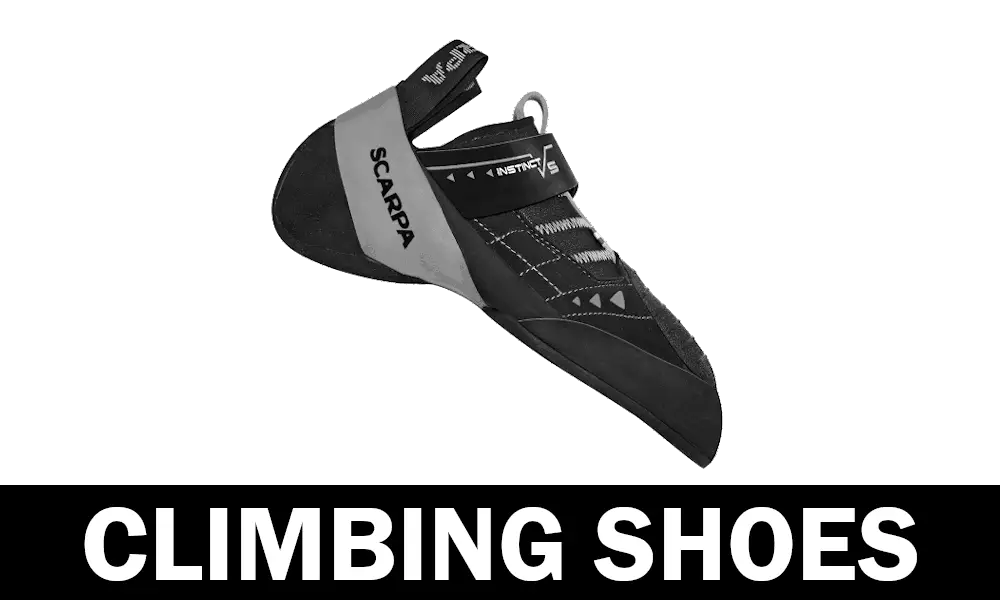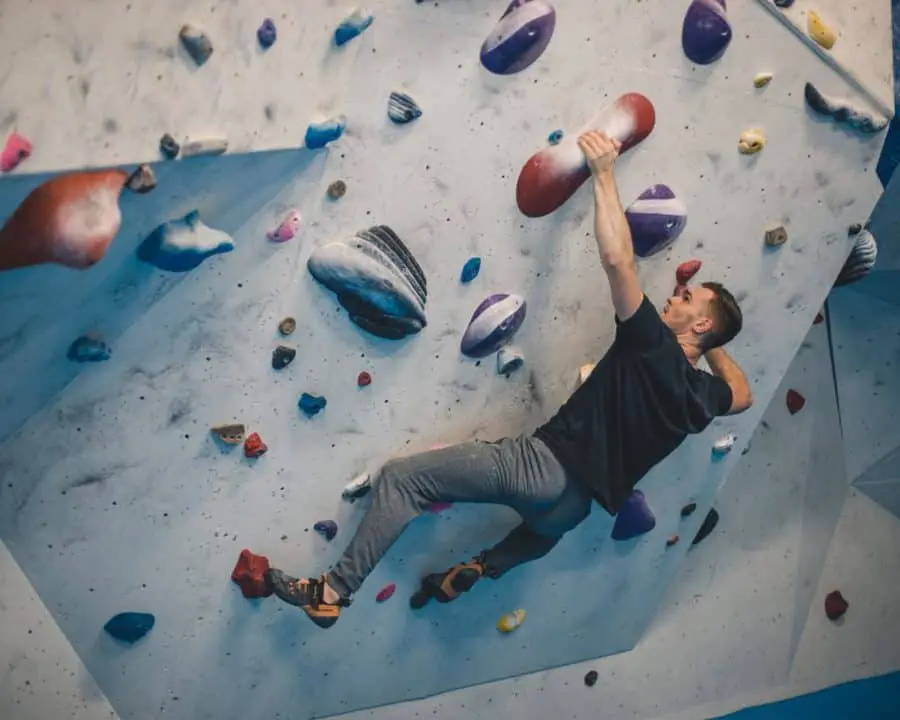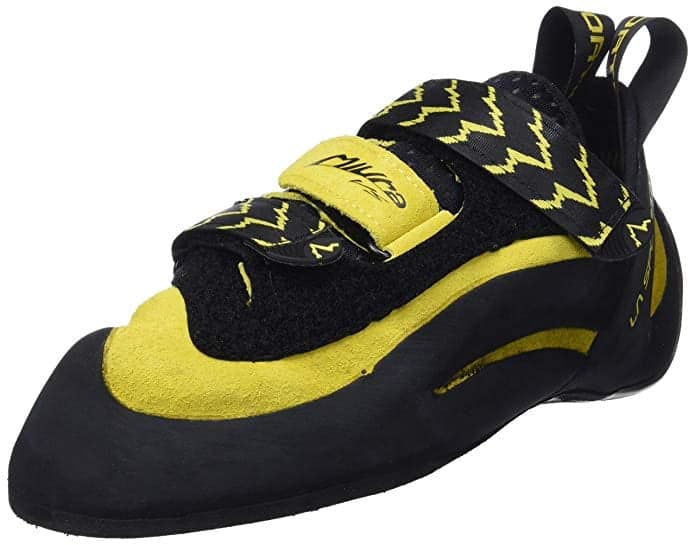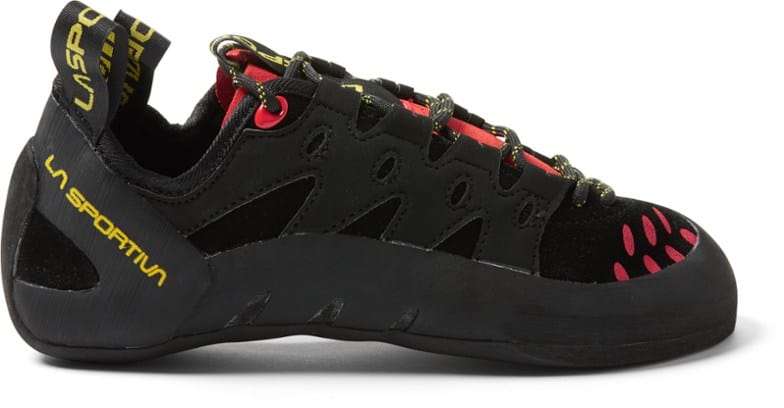
When buying climbing shoes there are a number of important factors to consider. For example, you need to think about what type of climbing you’re into. Are you a pure bred boulderer or lead climber, or do you need shoes that are more versatile? Would you be willing to buy a pair of climbing shoes that are less comfortable but more precise on their toe? Some shoes favor certain types of climbing over another, and other shoes are more well rounded.
My Top Picks for Climbing Shoes
Page Jumps

Why Are These Shoes the Best Choice?
For Versatility and Roped Climbing – La Sportiva Miura
- Shoe Type: Aggressive
- Upper: Leather
- Rubber: Vibram XS Edge rubber
- Good for: Versatility, precision, general comfort, edging, smearing
- Bad for: Slightly uncomfortable toe box, do not stretch length ways
The La Sportiva Miura has been known for years as one of, if not THE most well rounded shoe on the market. If you’re looking for a shoe that’s the best at one particular thing, then this isn’t it. But as a jack of all trades shoe you’re looking in the right place. Not only that but it’s great for wide feet.
For the durability, the price is certainly affordable. Durability is not an issue if you don’t crack climb as this is not their intended purpose. As long as you’re treating this shoe correctly, they’ll last you a long time. The upper material on this shoe is made of leather and the rubber used on the sole of the shoe is 4mm of Vibram© XS Edge which is a very durable type of rubber.
The shoes are quite uncomfortable when you’re breaking them in and stretching them with your feet. But after a few sessions of wearing them they’re fine. If you were to wear them all day you might start to feel a bit of pain, but for short term climbing the shoe isn’t that bad. It’s got three Velcro straps which help you adjust the shoe to your foot’s shape. But as it’s a curved shoe, it will start to get uncomfortable after two or three hours.
The precision of these shoes are excellent. Sometimes you feel like you’re wearing no shoes at all because you know where your big toe is, and you can feel exactly where to place it on even the thinnest of edges. If your foot slips off a hold you 100% cannot blame the shoe – it’s definitely bad footwork that caused the problem!
This is also great for smearing and pockets, however it’s not as downturned on the toe as some other high-end sport climbing shoes.
For Bouldering – Scarpa Instinct VS
- Shoe Type: Aggressive
- Upper: Synthetic leather
- Rubber: Vibram XS Edge rubber
- Good for: Bouldering, comfort, slabs, overhangs, heel hooking
- Bad for: Heat, breaking in period, thick rand
As an all round climbing shoe, the Scarpa Instinct VS is good alternative to the Muira. It’s the shoe I wear most because, in my opinion, it’s the perfect bouldering shoe! Don’t get me wrong, there are more precise shoes out there for short, steep routes. But the Scarpa Instinct VS is so comfy that I’d rather sacrifice a slight bit of precision to be able to climb an extra hour or two.
The upper material is made of synthetic suede, which is lighter but slightly less durable than leather. This also, unfortunately, sacrifices a bit of precision. However, it’s not enough for me to warrant buying more precise shoes and spending more money or losing too much comfort.
If you’re looking for a sensitive or precise shoe then you will get one here, it isn’t the absolute best but for me it’s precise enough alongside the durability and comfort of the shoe as well.
The Instinct VS has one of the best heel designs out there due to its tight fit and amazing ability to help heel hooks. There’s something beautiful about the balance it has between the thick heel and the rubber on the side which makes it perfect for heel hooks. I haven’t found another shoe as precise in the heel yet.
Small footholds are dealt with very well by the Instinct, due to the power and precision of the toe box. The rand (the thinner layer of rubber than wraps over the toe of the shoe) is thicker on this shoe, which unfortunately made it less sensitive.
Another negative point to be made about the Scarpa Instinct VS is the time it takes to break them in. I’ve had many pairs of these shoes and cringe every time I know I’ve got to get a new pair. The synthetic rubber takes a while to stretch out. This is also a reason why I don’t like climbing in the heat in these shoes – the rubber doesn’t stretch a lot so you can get uncomfortable when your feet swell.
I do love, however, how easy it is to take the shoes on and off without feeling uncomfortable as long as the shoes aren’t new or I’m not climbing in high heat. Generally these shoes are very comfortable and very easy to fit.
Last but not least, the performance of this shoe is fantastic on both slabs and overhangs. Not only is the toe great for small footholds but there’s a toe patch which is designed specifically for toe hooking. It’s the perfect bouldering shoe.
For Beginners – La Sportiva Tarantulace
- Shoe Type: Neutral
- Upper: Leather/synthetic leather
- Rubber: FriXion RS rubber
- Good for: Beginners, value for money, smearing, comfort
- Bad for: Aggressiveness, sensitivity, precision (compared to aggressive shoes)
The best beginners climbing shoe has to go to the La Sportiva Tarantulace in my personal opinion.
First of all, I find that laced shoes make the most sense for beginners because they can tighten or loosen their laces if they need more precision or feel when they’re on the wall. This gives them a bit more versatility. Beginners shoes aren’t as precise or aggressive as the shoes that more advanced climbers wear, so I would definitely recommend this feature.
The Tarantulace has leather and synthetic leather uppers which hugs comfortably around your foot, also allowing for a nice secure fit.
I’ve found that this shoe smears well on any terrain, which is especially surprising given how comfortable a pair of these are to wear.
The good thing about a comfortable shoe is that you’ll want to spend more time climbing in it, and it’s even better when its still more precise than most of the other neutral shoes around, especially for the affordable price.
The only other climbing shoe I’d recommend for beginners is the La Sportiva Finale, but I don’t think it’s worth it when it comes to value for money and here’s why.
When you’re a beginner you’ll use these shoes for a good 6-12 months before you feel comfortable enough on the wall to buy more aggressive shoes that fit more snug around your fit. By all means buy the more expensive shoes, but you’ll most likely be taking out your credit or debit card again near in the future for some more expensive shoes that will fit your needs at that point.
For Vegans – evolv Shaman
- Shoe Type: Aggressive
- Upper: Synthetic suede
- Rubber: TRAX XT-5 rubber
- Good for: Precision, comfort, vegans, lightweight, overhangs
- Bad for: Small foot holds, slab climbing
The evolv Shaman’s performance is high-level, giving you great sensitivity and precision while being able to house a wider foot. Not only does it feel comfortable for a wider foot but it feels tight at the tip of your toe which is where it helps you with sensitivity.
Personally, I love how light the shoe is while also being so supportive at the front of your feet. Recent upgrades to the toe patch and front strap have made the Shaman great at hard toe hooks.
The evolv Shaman seems to work well on sticking to overhangs which is probably where Chris Sharma comes in. It has a thicker rubber (4.2mm) than a lot of other technical shoes, but once you’ve broken them in you don’t really notice any lack of precision. The upgraded toe patch really helps toe hooking on overhanging rocks.
When on vertical walls or slabs, the Shaman has trouble with small footholds. This seems to be due to the thick rubber on the edge of the toe. When trying to place your big toe onto a smaller hold, the thicker rubber seems to lose form and unfortunately you won’t be able to trust them too much if the hold is unusually small.
Another upgrade the Shaman has seen recently has been on the heel. The heel rubber was originally quite thick, but since its upgrade from the previous model, the shoe has no problem with technical heel hooks. It’s also very comfortable around the heel while still being tight enough to feel precise.
The evolv Shaman is amazingly comfortable, even with its technical ability. Because of this it’s the shoe I would recommend most for anyone who has wide feet and does a lot of different types of climbing (other than for slabs). Aggressive shoes often feel uncomfortable around the edge of the foot (where a tailor’s bunion forms), but the Shaman never seemed to cause any problems here. Personally, I don’t have any Shaman’s anymore as I love slab climbing and I am fine substituting the comfort it offers for other attributes.
Attributes That Make a Good Climbing Shoe
- Value
This is how much the shoe is worth monetarily compared to how much I believe it’s worth when you apply it with the other aspects.
- Durability
This is how long the shoe will last before it starts to break down and what materials make up the shoe.
- Comfort
This is whether the shoe been worn all day without a problem or whether they cause your heel and toes to ache as soon as you put them on.
- Precision
This is where we see if the shoes good are enough at finding the smallest of foot holds and staying on them.
Climbing Shoe Types and What They Mean
There are three different types of climbing shoes to consider. The types of shoe are based on the aggressiveness of the sole arch. These types are known as neutral, moderate, and aggressive. Different shoe types are better for different types of climbing.
Neutral
Neutral shoes are really good at giving you comfort throughout a whole day’s climbing. If you don’t mind sacrificing precision for comfort then choosing a neutral climbing shoe is probably your best bet, however most advanced climbers won’t use neutral shoes, even for all day climbing. Neutral shoes are more suited to beginner climbers due to how comfortable they are. A lot of neutral shoes provide stiff midsoles with thick rubber which provides good support for your feet – however, this then means the shoes aren’t as sensitive and therefore don’t provide as much precision on a climb. Neutral shoes are also quite bad for overhangs due to the comfortable fit.
Moderate
Moderate shoes are good for slabs, multi-pitch climbs, and cracks due to the slight camber (downturned shape) on the sole. They’re more powerful than neutral shoes at overhangs as well due to the downturn of the sole. Although they are slightly less comfortable than neutral shoes, they provide more sensitivity and precision due to the thinner soles. Usually, they have stickier rubber on the bottom of the shoe for better grip. If you like overhangs, though, these aren’t as good as a more aggressive shoe. The thinner soles will also be less durable on moderate shoes than neutral shoes.
Aggressive
Aggressive shoes are typically uncomfortable but are made for sensitivity and precision. They are a lot better than neutral and even moderate shoes on overhanging climbs. Aggressive shoes put most of the focus on the big toe for precision on toe holds. Aggressive shoes aren’t suited for all day use, and are usually used for small routes and short gym sessions. Moderate and neutral shoes are actually better at smearing than aggressive shoes. Aggressive shoes also use thinner rubber for the soles which means that it wears faster than neutral and even some moderate climbing shoes.
Ways to Wear Your Climbing Shoe
There are three different ways to tighten or wear your climbing shoe. These are by using laces, using a Velcro strap, or by using slip-on climbing shoes which have some sort of elastic built in to keep the shoes from falling off your feet.
Laces
Laces are the most versatile due to the fact you can loosen them if it gets hot and your feet swell up or if you want to tighten your shoes up to give maximum output/precision.
Straps
Velcro straps are for ease of use when climbing. They’re easy to take off and put back on in no time. If you want this kind of convenience without the need to tie a knot, these might be your best bet.
Slip-Ons
Slip-on shoes are great for sensitivity and are really convenient for taking your shoes off and putting them back on. If you climb on rocks with thin cracks, slip-ons may be perfect for you due to their thin profile.
Climbing Shoe Sizing
It is imperative that you buy the right size climbing shoes unless you are fine with putting your feet at risk when it comes to developing different problems. Wearing shoes that are too small for you can cause many different ailments, some that are hard to fix and very painful. These are:
- Bunions – a lump on a part of the foot that may be uncomfortable and cause pain
- In-grown toe nails – a nail may grow inward which may cause pain and infection
- Metatarsalgia – achy or sharp pain felt around the ball of the foot
- Corns and/or calluses – ugly, hard layers of skin which are there to protect your skin against friction and/or pressure
- Morton’s Neuroma – a condition that can cause numbness, pain, and/or tingling in the foot, believed to be caused by a trapped nerve
- Nail bed infection – usually caused by in-grown toe nails
- Subungual Hematoma – bleeding under the toe nail
- Toe Deformities – toes can be forced into a certain direction causing permanent damage
When you’re in the store trying on climbing shoes, you might find a pair that really suit your style of climbing and feel good to walk around in on the shop floor. Then you put them on and start climbing in them, only to realize you’ve made a grave error due to pain in your feet and can’t return them because of a no-return policy once they’ve been used on the wall. This has happened to me on occasion and I’ve got to say I’ve definitely learnt from it.
First off, we have to wonder why your shoes are ok when you wear them on the shop floor and they aren’t ok once you start climbing. It’s pretty simple, once you start climbing your feet swell up and therefore cause your shoes to feel tighter than they previously were. If they felt snug before, they’ll feel even more uncomfortable (or even painful) now.
So how can we avoid this? Well, there’s something you can do: go for a long walk or do some other sort of exercise that will encourage your feet to swell up before you buy your shoes.
If you’re in your local climbing gym and you’re going to buy your shoes from there, it may well be a good idea to actually climb for a little bit with some old or rented shoes and then go and try some on in the shop. This will swell your feet up to the normal amount that would occur when you climb.
For information of shoe sizing take a look at this long article I wrote by clicking here.
One Last Thing…
When shopping around keep in mind you can find well priced climbing shoes online, however, I’d encourage you to try them on first if possible for the reasons mentioned above. Climbing shoes shouldn’t hurt when you wear them, however they should feel snug without any room at the end of your toe. Climbing in shoes that are painful will actually hinder your ability on the wall.




